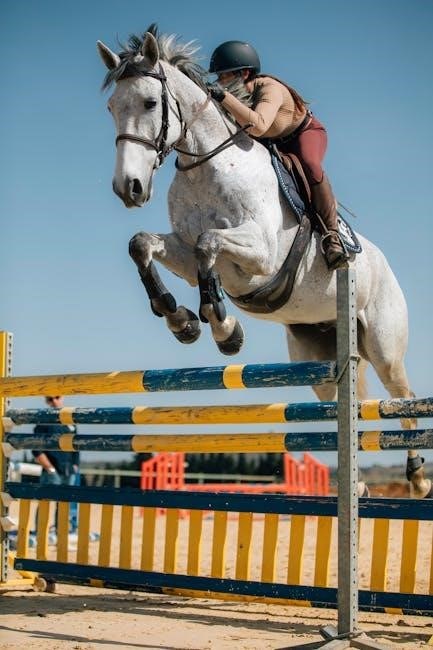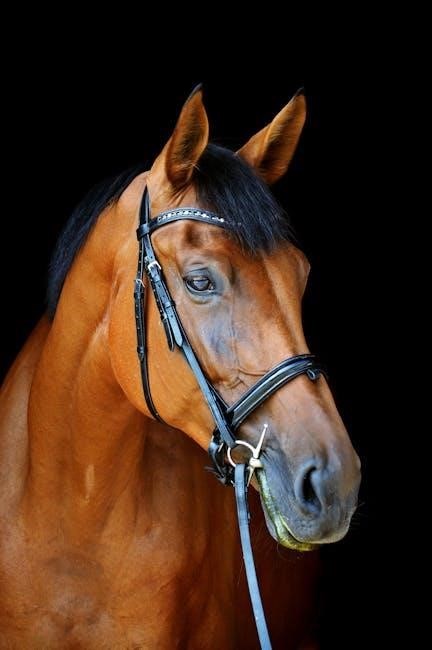Intro C Dressage Test PDF: A Comprehensive Guide
This guide offers a comprehensive overview of the Intro C Dressage Test‚ available in PDF format. It serves as an invaluable resource for riders and horses new to dressage‚ aiming to develop elementary skills. This test is designed to encourage correct performance and prepare for transition to USEF tests.
Intro C Dressage Tests serve as a foundational step for both horse and rider embarking on their dressage journey. These tests‚ often available as PDFs‚ are specifically designed to introduce the fundamental principles of dressage in a simplified and accessible manner. They aim to build a solid understanding of basic movements and horsemanship. The Intro C level focuses on establishing correct performance and preparing participants for more advanced USEF tests.
These tests typically involve walk‚ trot‚ and canter work‚ emphasizing rhythm‚ balance‚ and clear transitions. Riders are evaluated on their ability to guide the horse forward with a steady tempo‚ maintaining elastic contact through independent and steady hands‚ and a correctly balanced seat. Geometry and accuracy in figures‚ such as circles and corners‚ are also key components.

Intro C tests provide an opportunity to showcase elementary skills while encouraging a harmonious partnership between horse and rider. Successful completion of Intro C tests indicates a readiness to progress to higher levels of dressage competition.
The tests are readily available online‚ often offered by organizations like USDF and USEF. Dressage Ireland also provides Intro tests. Understanding the requirements and objectives of Intro C is essential for any aspiring dressage enthusiast.
Purpose of Intro C Tests
The primary purpose of Intro C Dressage Tests is to introduce riders and horses to the fundamental principles and requirements of the sport of dressage. These tests serve as an entry point‚ confirming that participants are beginning to grasp the essential elements of correct dressage basics.
Intro C tests are designed to develop an understanding of riding the horse forward with a steady tempo and clear rhythm‚ encouraging the horse to accept contact with the bit. They emphasize the importance of maintaining an elastic connection between horse and rider through independent‚ steady hands and a correctly balanced seat.
Furthermore‚ these tests aim to instill proper geometry of figures within the arena‚ focusing on accurate execution of corners and circles with correct bend. By mastering these figures‚ riders and horses lay the groundwork for more complex movements in higher-level tests.
Intro C also serves as a stepping stone towards USEF tests‚ preparing both horse and rider for the challenges and expectations of formal dressage competition. The overarching goal is to foster a harmonious partnership and a solid foundation in dressage principles.
Ultimately‚ Intro C tests aim to encourage correct performance‚ build confidence‚ and promote a positive introduction to the world of dressage.
Key Elements of the Intro C Test
The Intro C Dressage Test encompasses several key elements designed to assess the foundational skills of both horse and rider. A central focus is the horse’s ability to move forward with a steady tempo and clear rhythm‚ accepting consistent contact with the bit. This forward movement should be balanced and demonstrate a willingness to work.
Transitions between gaits are crucial‚ emphasizing smoothness and responsiveness. The test will include transitions between walk‚ trot‚ and canter‚ demanding clear communication and a horse that is attentive to the rider’s aids.
Geometry and accuracy of figures are also paramount. Riders must demonstrate the ability to accurately execute circles‚ corners‚ and changes of direction‚ showcasing control and precision in the arena.
The rider’s position and seat play a vital role. A balanced and effective seat‚ along with independent hands‚ are essential for guiding the horse and maintaining correct posture. The rider’s ability to influence the horse subtly is key to success.
Finally‚ the overall harmony and partnership between horse and rider are considered. The test evaluates the horse’s willingness‚ obedience‚ and the rider’s ability to present the horse in a relaxed and confident manner.
Walk Work in Intro C
The walk work in the Intro C Dressage Test focuses on establishing a clear and consistent rhythm‚ demonstrating the horse’s relaxation and willingness to move forward. A key component is the medium walk‚ where the horse should display a purposeful stride with good ground cover while maintaining a steady tempo. The rider’s seat and aids should encourage the horse to stretch into the contact.
Transitions into and out of the walk are also evaluated‚ emphasizing smoothness and responsiveness. The horse should transition willingly without any resistance or loss of balance. The rider’s ability to communicate effectively through subtle cues is crucial.
The test also incorporates the free walk on a long rein‚ allowing the horse to stretch its neck and back‚ demonstrating relaxation and trust in the rider. The free walk provides an opportunity to assess the horse’s natural movement and suppleness.
Throughout the walk work‚ the rider’s position and balance are essential. A steady and correct seat allows the rider to influence the horse without disrupting its natural rhythm. Independent hands maintain a consistent contact‚ encouraging the horse to accept the bit.
Accurate geometry and straightness are also important considerations in the walk work‚ setting the foundation for more advanced movements in the test.
Trot Work in Intro C
In the Intro C Dressage Test‚ the trot work is a significant element‚ designed to assess the horse’s basic training and the rider’s ability to influence its movement. The test primarily involves working trot‚ which can be executed either rising or sitting unless specified otherwise. The emphasis is on maintaining a consistent rhythm‚ balance‚ and forward momentum.

Circles at the trot‚ typically 20 meters in diameter‚ are common figures used to evaluate the horse’s bend and suppleness. The rider should demonstrate proper geometry and maintain an even pace throughout the circle‚ ensuring the horse remains balanced and responsive to the aids.
Transitions between gaits‚ such as walk to trot and trot to walk‚ are also important aspects of the trot work. These transitions should be smooth‚ prompt‚ and without resistance from the horse. The rider’s ability to communicate effectively through subtle cues is crucial for achieving seamless transitions.

Straight lines at the trot are used to assess the horse’s straightness and the rider’s ability to maintain a consistent contact. The horse should move forward with a steady tempo and clear rhythm‚ accepting the bit and responding to the rider’s aids.
Throughout the trot work‚ the rider’s position and balance are critical. A correct seat and independent hands allow the rider to influence the horse’s movement without disrupting its natural rhythm. The overall goal is to demonstrate the horse’s willingness to work and its ability to perform basic dressage movements with accuracy and precision.
Canter Work in Intro C
The canter work in the Intro C Dressage Test introduces a higher level of skill‚ evaluating the horse’s balance‚ rhythm‚ and response to the rider’s aids at a more demanding gait. The test typically includes short canter segments to assess the horse’s ability to maintain a consistent tempo and smooth transitions.
Transitions from trot to canter and canter to trot are key components‚ often performed through a walk step to ensure a smooth and balanced change of gait. The rider should demonstrate clear and effective communication‚ allowing the horse to transition willingly and without resistance.
The canter work focuses on maintaining a steady rhythm and balance‚ showcasing the horse’s ability to carry itself in a collected and controlled manner. While extended canter strides are not typically required at this level‚ the horse should demonstrate a clear three-beat canter with adequate impulsion.
Circles or changes of direction at the canter may be included to assess the horse’s suppleness and responsiveness to the rider’s aids. The rider should maintain proper bend and balance throughout the movements‚ ensuring the horse remains comfortable and willing.
Overall‚ the canter work in Intro C aims to introduce the horse and rider to the fundamentals of canter work in dressage‚ emphasizing clear transitions‚ steady rhythm‚ and a balanced‚ harmonious partnership. The focus is on demonstrating potential and willingness rather than advanced technical skills.
Geometry and Figures in Intro C
Geometry and figures form a fundamental aspect of the Intro C Dressage Test‚ assessing the rider’s accuracy and control in navigating the arena. Correctly executed figures demonstrate the rider’s understanding of spatial awareness and the horse’s responsiveness to directional aids.
Circles‚ typically 20 meters in diameter‚ are a common element‚ requiring the rider to maintain a consistent bend and rhythm while accurately tracing the circular path. The horse should remain balanced and supple‚ responding to the rider’s inside leg and outside rein to maintain the correct shape.
Straight lines are equally important‚ demanding the rider to maintain a consistent track and straightness of the horse. Deviations from the straight line can indicate imbalances or a lack of control‚ resulting in deductions from the judge.
Corners are also assessed‚ requiring the rider to prepare the horse for the turn and maintain balance and rhythm throughout the movement. The horse should bend slightly to the inside‚ engaging its hindquarters to maintain impulsion.
Transitions between figures should be smooth and seamless‚ demonstrating the rider’s ability to maintain control and communication with the horse. Accurate placement of figures within the arena showcases the rider’s understanding of geometry and the horse’s responsiveness to directional aids. Ultimately‚ precise geometry enhances the overall presentation and highlights the rider’s skill in guiding the horse.
Dressage Ireland Intro C Test (2017)
The Dressage Ireland Intro C Test (2017) is specifically designed to introduce riders and horses to the fundamentals of dressage within the Irish equestrian system. This test serves as a stepping stone for those new to the discipline‚ focusing on establishing basic skills and correct training principles.
The test evaluates the rider’s ability to guide the horse through a series of movements‚ including walk‚ trot‚ and potentially canter‚ depending on the specific requirements. Emphasis is placed on maintaining a steady tempo‚ clear rhythm‚ and correct bend throughout the test.
Riders are expected to demonstrate proper geometry in figures such as circles and straight lines‚ showcasing their understanding of arena management and the horse’s responsiveness to directional aids.
The Dressage Ireland Intro C Test (2017) also assesses the rider’s position and seat‚ as well as their ability to maintain an elastic contact with the horse’s mouth. Judges look for a harmonious partnership between horse and rider‚ with the horse moving freely and willingly.
This test provides a valuable opportunity for riders to gain experience in the competition arena and receive constructive feedback from qualified judges‚ ultimately promoting the development of both horse and rider within the Dressage Ireland framework. The 2017 version ensures standardized assessment.
USDF Intro C Test
The USDF Intro C Test is a foundational dressage test recognized by the United States Dressage Federation (USDF). Designed for novice horse and rider combinations‚ it serves as an entry point into the world of competitive dressage‚ emphasizing basic horsemanship and correct training principles.

The test typically includes movements at the walk‚ trot‚ and canter‚ assessing the horse’s willingness to move forward with a steady tempo and clear rhythm. Riders are evaluated on their ability to maintain an elastic contact with the horse’s mouth‚ demonstrating independent and steady hands.
Geometry and accuracy are crucial elements‚ with riders expected to execute figures such as circles and changes of direction with precision. The test also assesses the rider’s position and seat‚ as well as their ability to effectively use their aids to communicate with the horse.
The USDF Intro C Test aims to develop an understanding of correct dressage basics‚ encouraging riders to focus on balance‚ bend‚ and the overall harmony between horse and rider. It provides a valuable opportunity for newcomers to gain experience in the competition arena and receive feedback from qualified judges.
Success in this test demonstrates a solid foundation in dressage principles and prepares horse and rider for progression to higher levels within the USDF system.
USEF Intro C Test
The USEF Intro C Test‚ sanctioned by the United States Equestrian Federation (USEF)‚ is a fundamental dressage test aimed at introducing riders and horses to the sport. This test focuses on elementary skills‚ providing an opportunity for new combinations to demonstrate their understanding of basic dressage principles.
The purpose of the USEF Intro C Test is to confirm that the horse and rider are beginning to develop correct dressage basics. The test requires the horse to be ridden freely forward in a steady tempo and clear rhythm‚ accepting contact with the bit. Riders are assessed on their position‚ seat‚ and effective use of aids.
The test typically involves walk‚ trot‚ and canter work‚ including transitions between gaits and changes of direction. Proper geometry of figures in the arena‚ such as circles and corners‚ is also evaluated‚ emphasizing correct bend and balance.
The USEF Intro C Test serves as a stepping stone for riders and horses new to dressage‚ preparing them for more advanced USEF tests. It encourages correct performance and provides a framework for developing essential dressage skills.
This test plays a crucial role in the development of both horse and rider‚ promoting a harmonious partnership and a solid foundation in dressage principles.
CCI1 Intro C Dressage Test
The CCI1 Intro C Dressage Test is a specific dressage test used in Fédération Équestre Internationale (FEI) Eventing competitions at the CCI1* level. This test serves as an introductory level for eventing combinations‚ assessing their basic dressage skills and preparation for more demanding phases of eventing.
The CCI1 Intro C Dressage Test evaluates the horse’s gaits‚ submission‚ and the rider’s effectiveness in presenting the horse. It includes movements at the walk‚ trot‚ and canter‚ with transitions and figures designed to demonstrate the horse’s balance‚ rhythm‚ and obedience. The test emphasizes correct basics‚ such as a steady tempo‚ elastic contact‚ and proper geometry of figures.
Specific requirements for the CCI1 Intro C Dressage Test may include using a snaffle bridle only. The test may also specify whether trot work should be executed sitting or rising. Riders are expected to demonstrate an understanding of correct dressage principles while maintaining the horse’s forward movement and acceptance of the bit.
The CCI1 Intro C Dressage Test is an important component of the CCI1* eventing competition‚ providing a foundation for the jumping and cross-country phases. Successful completion of the test requires a harmonious partnership between horse and rider‚ showcasing their training and preparation for the challenges of eventing.
Scoring and Judging in Intro C Tests
Scoring and judging in Intro C dressage tests are crucial for evaluating the performance of both horse and rider. Judges assess each movement based on a scale‚ typically from 0 to 10‚ with specific criteria for each mark. A score of 6 is generally considered a satisfactory or passing mark‚ indicating that the movement was performed adequately.
Judges evaluate various aspects‚ including the horse’s gaits (walk‚ trot‚ canter)‚ submission‚ and the rider’s position and effectiveness. They also consider the accuracy of figures‚ transitions between gaits‚ and the overall harmony between horse and rider. The judge looks for a steady tempo‚ clear rhythm‚ and the horse’s acceptance of the bit.
Throughout the test‚ errors can result in deductions from the overall score. Common errors include incorrect figures‚ poor transitions‚ resistance from the horse‚ and rider position faults. Judges are trained to identify and penalize these errors accordingly. Collective marks are awarded for overall impression‚ rider’s position‚ and the horse’s gaits‚ impulsion‚ and submission.
The final score is calculated by summing the individual movement scores and deducting any penalties. The rider with the highest score wins the class. Understanding the scoring system and judging criteria is essential for riders to improve their performance and achieve better results in Intro C dressage tests.


